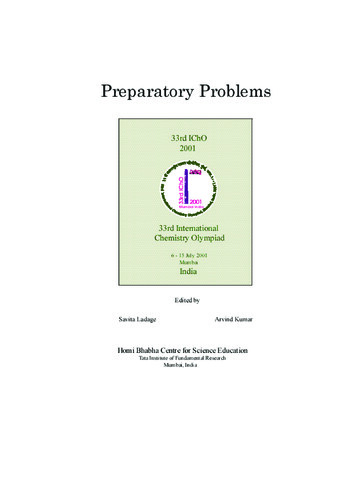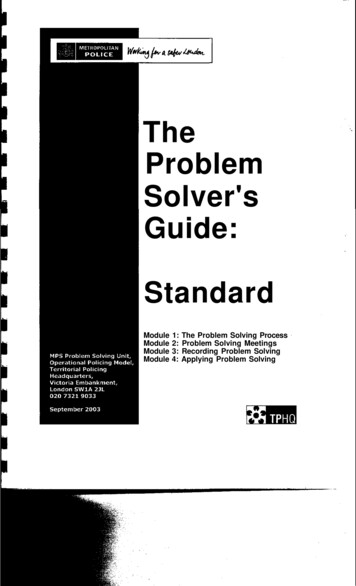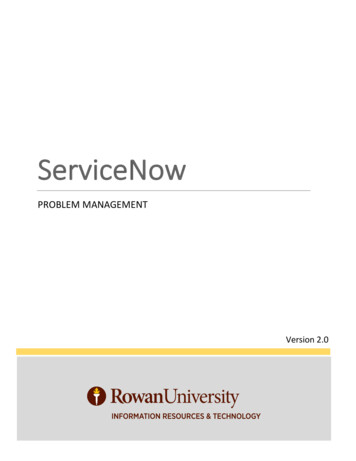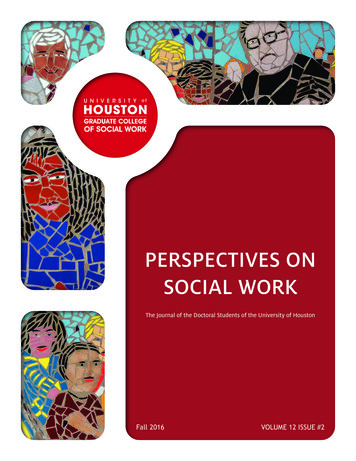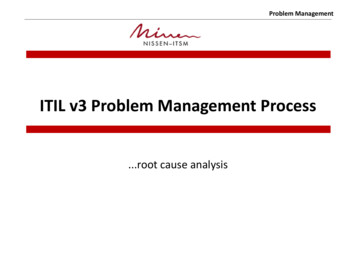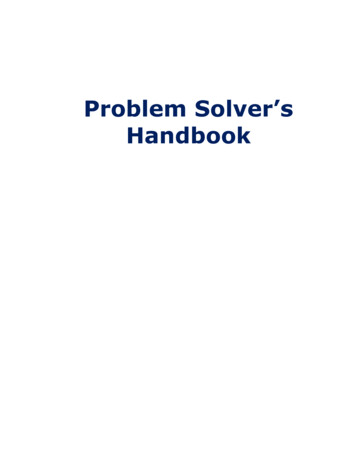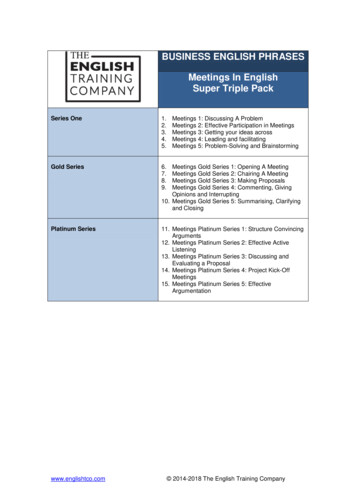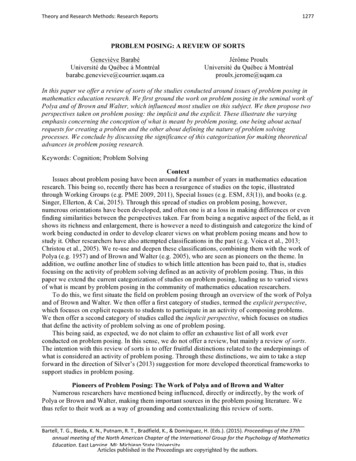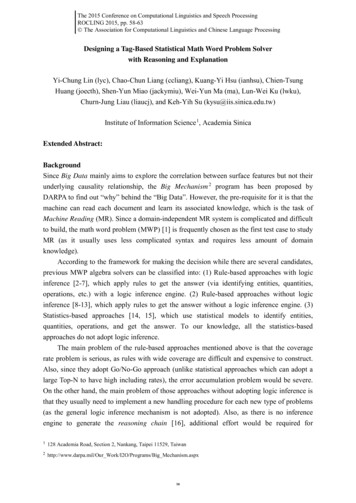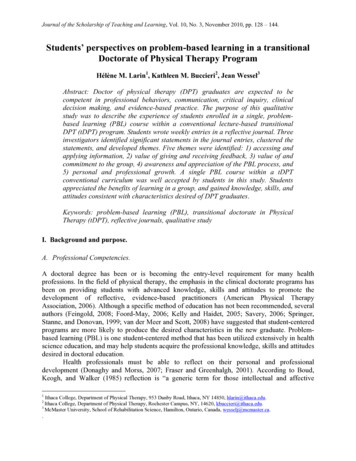
Transcription
Journal of the Scholarship of Teaching and Learning, Vol. 10, No. 3, November 2010, pp. 128 – 144.Students’ perspectives on problem-based learning in a transitionalDoctorate of Physical Therapy ProgramHélène M. Larin1, Kathleen M. Buccieri2, Jean Wessel3Abstract: Doctor of physical therapy (DPT) graduates are expected to becompetent in professional behaviors, communication, critical inquiry, clinicaldecision making, and evidence-based practice. The purpose of this qualitativestudy was to describe the experience of students enrolled in a single, problembased learning (PBL) course within a conventional lecture-based transitionalDPT (tDPT) program. Students wrote weekly entries in a reflective journal. Threeinvestigators identified significant statements in the journal entries, clustered thestatements, and developed themes. Five themes were identified: 1) accessing andapplying information, 2) value of giving and receiving feedback, 3) value of andcommitment to the group, 4) awareness and appreciation of the PBL process, and5) personal and professional growth. A single PBL course within a tDPTconventional curriculum was well accepted by students in this study. Studentsappreciated the benefits of learning in a group, and gained knowledge, skills, andattitudes consistent with characteristics desired of DPT graduates.Keywords: problem-based learning (PBL), transitional doctorate in PhysicalTherapy (tDPT), reflective journals, qualitative studyI. Background and purpose.A. Professional Competencies.A doctoral degree has been or is becoming the entry-level requirement for many healthprofessions. In the field of physical therapy, the emphasis in the clinical doctorate programs hasbeen on providing students with advanced knowledge, skills and attitudes to promote thedevelopment of reflective, evidence-based practitioners (American Physical TherapyAssociation, 2006). Although a specific method of education has not been recommended, severalauthors (Feingold, 2008; Foord-May, 2006; Kelly and Haidet, 2005; Savery, 2006; Springer,Stanne, and Donovan, 1999; van der Meer and Scott, 2008) have suggested that student-centeredprograms are more likely to produce the desired characteristics in the new graduate. Problembased learning (PBL) is one student-centered method that has been utilized extensively in healthscience education, and may help students acquire the professional knowledge, skills and attitudesdesired in doctoral education.Health professionals must be able to reflect on their personal and professionaldevelopment (Donaghy and Morss, 2007; Fraser and Greenhalgh, 2001). According to Boud,Keogh, and Walker (1985) reflection is “a generic term for those intellectual and affective1Ithaca College, Department of Physical Therapy, 953 Danby Road, Ithaca, NY 14850, hlarin@ithaca.edu.Ithaca College, Department of Physical Therapy, Rochester Campus, NY, 14620, kbuccieri@ithaca.edu.3McMaster University, School of Rehabilitation Science, Hamilton, Ontario, Canada, wesselj@mcmaster.ca.2.
Larin, H. M., Buccieri, K. M., and Wessel, J.activities in which individuals engage to explore their experiences in order to lead to newunderstandings and appreciations” (p. 19). Kuiper and Pesut (2004) argue that both cognition(critical thinking, reasoning) and metacognition [reflection on one’s own cognitive and learningprocesses (Cheong, 2008)] are essential and integrated parts of clinical reasoning. Educators seekto incorporate instructional strategies that will help their students develop clinical reasoning andreflection.B. The Problem-Based Learning Approach.Problem-based learning has been suggested as one of the educational methods that facilitate bothcognition and metacognition skills (Foord-May, 2006; Lusardi, Levangie, and Fein, 2002; Uhlin,Johannesson, and Silén, 2007; Williams, 2001). In a PBL course, learning is structured around arealistic case scenario that provides context to facilitate reflection and critical thinking (Kuiperand Pesut, 2004). Students learn in groups with guidance from a tutor. They define individualand group learning needs, and search for and critically apply findings to the case scenario(Dolmans et al, 2005). Students must select and organize relevant information and communicateeffectively with their peers. The ability to apply information clinically is dependent, in part, onhow one organizes and accesses knowledge (Norman and Eva, 2003). In PBL courses, studentsare practicing organizational and retrieval skills that will be useful for making and applyingclinical decisions, interacting with patients and colleagues, and becoming lifelong learners(Lusardi, Levangie, and Fein, 2002).Self- and peer-assessments are components of PBL that may be particularly useful forpromoting reflection in physical therapy students. In a PBL course, students are required toevaluate themselves, their peers and tutors during tutorial sessions. This weekly oral feedbackmay cover any of the expected tasks of PBL, e.g., defining learning objectives, accessing,organizing and applying relevant information, and professional behavior, such as punctuality,communication and respect for others. Students are expected to modify their behavior inresponse to feedback, and to note and suggest change in others. Williams (2001) articulates thatthe feedback component of a PBL course promotes students’ reflections on their actions andfacilitates development of strategies for improved performance.C. Problem-Based Learning Literature.Authors conducting reviews of the literature over the past 20 years (Norman and Schmidt, 1992;Albanese and Mitchell, 1993; Dochy et al, 2003; Koh et al, 2008), have reported that PBLsustained self-directed learning, and improved resource use, collaborative skills, retention ofknowledge, knowledge application, and transfer of concepts to new problems. In their recentsystematic review, Koh and colleagues (2008) reported positive effects of PBL on physiciancompetencies after graduation especially in the social and cognitive areas. The authors indicatedthat there was strong evidence to support the positive effect of PBL on several observedcompetencies of medical graduates: diagnostic skills or accuracy, communication skills,appreciation of cultural, legal and ethical aspects of health care, coping with uncertainty,responsibility and reliability, and self- or peer appraisal. Ozturk et al (2008) reported evidencethat PBL encouraged critical thinking in nursing students; and, Richards et al (1996) andDistlehorst and Robbs (1998) noted the superior clinical performance of PBL students. Finally,Journal of the Scholarship of Teaching and Learning, Vol. 10, No. 3, November 2010.www.iupui.edu/ josotl129
Larin, H. M., Buccieri, K. M., and Wessel, J.from their meta-synthesis of meta-analyses, Strobel and van Barneveld (2009) concluded that“PBL is significantly more effective than traditional instruction to train competent andskilled practitioners and to promote long-term retention of knowledge and skills acquiredduring the learning experience or training session” (p. 55). These studies have provided evidencethat PBL fosters many of the characteristics desired in doctoral level PT graduates.Some authors (Colliver, 2000; Dochy et al, 2003; Albanese and Mitchell, 1993;Albanese, 2000; Saarinen-Rahiika and Binkley, 1998; Mann and Kaufman, 1999; Jefferson,2001; Solomon, 2005; Rideout et al, 2002; Koh et al, 2008) have reported that PBL is notsuperior to conventional educational approaches in all aspects of learning. For example, studentswho studied in a PBL curriculum demonstrated lower levels of content-specific knowledge andbasic sciences and scored the same or lower on examinations compared to students inconventional programs (Dochy et al, 2003; Albanese and Mitchell, 1993). Students in PBL alsoperceived themselves as having lower knowledge even when they had performed as well asstudents from conventional programs on board examinations (Koh et al, 2008; Mann andKaufman, 1999). Jefferson (2001) concluded from his review that PBL did not improve students’problem-solving skills and Colliver (2000) found no convincing evidence that PBL improvesknowledge and clinical performance.D. Problem-Based Learning and Physical Therapy.Studies of physical therapy students have provided support for the suggested effects of PBL onprofessional skills and behaviors. These have included investigations on students in fullyintegrated PBL curricula, and those in stand-alone PBL courses. Van Langenberghe (1988)reported that students in PBL have more desirable personal study habits. Physical therapystudents during the first term of a fully integrated PBL program described an improved ability toaccess appropriate information, an appreciation of giving and receiving feedback, and anincreased awareness of group process and group methods of learning (Williams, MacDermid,and Wessel, 2003). Students in a first year PBL ethics course felt they improved their criticalthinking and problem-solving skills and their ability to speak in front of others (Uhlin,Johannesson, and Silén, 2007). In an attempt to evaluate the effect of a PBL course on lifelonglearning, Wiegand, Gillette, and Brosky (2005) surveyed physical therapists two to four yearsafter graduation. Those that had taken a PBL course on professional issues felt more prepared todevelop and implement continuing education courses than those who had covered the samecurricular content in a conventional course.A thorough review of the literature revealed only one study examining the reactions ofstudents to a single, PBL course within a 3-year DPT program (Santasier and Plack, 2007). TheCase Study I course was full time for one week, held between semesters of conventionalcurricula and incorporated cycles of action and reflection. The authors analyzed qualitative datafrom the individual, reflective essays of 25 students who answered the question on whether thecourse objectives addressing professional behaviors were met, and from graphic metaphorscreated by groups of 3 or 4 students to depict what the course was like for them. Studentsreported enhanced critical thinking, commitment to learning, interaction skills, stressmanagement, and professional identity. The authors noted that the graphic metaphors “furthersupported the integration, synthesis, and personal growth in professional behaviors” (Santasierand Plack, 2007, p. 35).Journal of the Scholarship of Teaching and Learning, Vol. 10, No. 3, November 2010.www.iupui.edu/ josotl130
Larin, H. M., Buccieri, K. M., and Wessel, J.Several authors (Dolmans et al., 2005; Lusardi, Levangie, and Fein, 2002) have called forfurther research to better understand the theoretical concepts underlying PBL, and the impact ofPBL on students’ transition to clinical practice and lifelong learning. No studies have reportedthe reactions of students to a single PBL course within a conventional, lecture-based curriculumdesigned for transition to a DPT. The response of students to a single PBL course near the end oftheir professional education may be different from that of students who participated in PBL stylecourses throughout their program. The purpose of this qualitative study was to describe physicaltherapy students’ perceptions of their experience and learning during participation in a singlePBL course within a transitional DPT (tDPT) lecture-based curriculum.II. Methods.A. Design.This study followed a phenomenological, qualitative approach (Creswell, 2007). Researchers usethis method when they wish to describe the lived experiences of people involved with the topicbeing studied. We chose this design to capture the PBL experience from the personal perspectiveof the students. Students wrote weekly reflections over the 10-week time period of a single PBLcourse. The three investigators read the journal entries and developed themes.B. Participants.Sixty-three physical therapy students (15 male and 48 female, mean age 23.6 years, range 22.127.7 years) enrolled in a PBL Case Study Seminar course within a lecture-based tDPTcurriculumwere invited to participate in the study. All students had completed an entry-level Master ofScience in Physical Therapy (MSPT) degree with 30 weeks of clinical education course work.Sixty-one of these students had not yet been employed as physical therapists. Two students werealumni who had graduated within the past 5 years and had been in clinical practice prior toenrolling in the course. The study was approved by the All College Review Board for HumanSubjects Research of Ithaca College, and participants provided written informed consent.C. Educational Program and PBL Course.The tDPT program was solely available to Ithaca College graduates holding a MSPT degree. The10-week, on-site, tDPT curriculum consisted of 6 intensive courses, one of which was CaseStudy Seminar, the only PBL course offered in the entire physical therapy curriculum (MSPTand tDPT). The course was designed to help students integrate previous academic and clinicalcoursework, expand professional knowledge, develop skills in communication and reflection,and design treatments based on evidence. Groups of six to seven students, facilitated by a tutor,met for two hours weekly to discuss a series of written health care scenarios. Students wererequired to work together to identify weekly learning issues. They individually located, accessed,evaluated and organized evidence relevant to the case. Knowledge was discussed and applied tothe client scenario during the next tutorial session. The cases covered a broad scope of physicaltherapy practice, were complex and multidisciplinary in nature, and included patients of variousage groups and cultural backgrounds. Peer, tutor and self-assessments occurred orally at eachtutorial session, and in written and oral format at midterm and at the end of the course.Journal of the Scholarship of Teaching and Learning, Vol. 10, No. 3, November 2010.www.iupui.edu/ josotl131
Larin, H. M., Buccieri, K. M., and Wessel, J.All tutors attended eight hours of PBL training workshops, had a minimum of two yearsexperience with the PBL approach, and had been involved in the tDPT program for the past threeyears. The course coordinator provided the course syllabus and a tutors’ guide which includedthe learning objectives and relevant literature for each case scenario. Tutors attended weeklymeetings with the course coordinator to discuss the progression of the course, studentperformance and facilitation strategies to enhance students’ learning.D. Data Collection and Analysis.Reflective journal writing was used as a means of gathering students’ perceptions on their firstexperience with PBL. Previous investigators have used this method to study the process oftransitional adjustment of adult learners in their first year of higher education (Risquez, Moore,and Morley, 2007-2008), and of physical therapy students entering a PBL curricular program(Uhlin, Johannesson, and Silén, 2007; Williams, MacDermid, and Wessel, 2003). Both studentsand faculty in previous studies have commented on the value of journal writing to betterunderstand the students’ experience with PBL (Uhlin, Johannesson, and Silén, 2007; Williams,MacDermid, and Wessel, 2003).As part of the Case Study Seminar course, each student was required to complete andsubmit a reflective journal about their experience and their understanding of the process ofproblem-based, self-directed learning. They were to include observations, impressions, andreactions to what and how they were learning, and to relate these to previous learning andpotential future behavior. Students were awarded 1% for each completed weekly journal entryfor a total of 10% of the course grade. At mid-course and in the final week, the coursecoordinator reminded students to write in their reflective journals.On the first day of the last week of the course, the principal investigator sent an e-mail tothe students inviting their participation in the study. The students were assured that their decisionto participate or not participate would have no impact on the course grade. The investigatorswould access the reflective journals for qualitative analysis of content only after the students’graduation date. Students received no incentives to participate and were offered a summary ofthe results at the end of the study upon request. At the end of the course, all students submittedtheir journals to an administrative assistant. To protect the anonymity of the students, a researchassistant removed the names from the journals of all participants, replaced names with codenumbers, and delivered the coded journals to the investigators.Three investigators were involved in the qualitative analysis of the journals. Oneinvestigator was the Case Study Seminar course coordinator and a tutor, the second, a tutor in thecourse, and the third, a faculty member from another university with no involvement in thistDPT program. All three investigators were experienced educators and scholars in the professionof physical therapy. Their combined clinical and research expertise included pediatric neurology,orthopedics, rheumatology, moral judgment and clinical education. Two of the investigators hadextensive experience in teaching in PBL curricula and had utilized reflective journals in previousresearch (Larin, Wessel, and Al-Shamlan, 2005; Williams, MacDermid and Wessel, 2003;Williams et al, 2002). Each investigator brought to the analysis of the reflective journals adifferent awareness based on their respective experiences in physical therapy.Initially, the three investigators independently read five randomly selected journals andhighlighted significant statements representative of how the participants experienced the PBLcourse. They then began to group the statements into large units of information or categories andJournal of the Scholarship of Teaching and Learning, Vol. 10, No. 3, November 2010.www.iupui.edu/ josotl132
Larin, H. M., Buccieri, K. M., and Wessel, J.met to revise and establish agreement on the categories. They then reread and searched for theagreed categories, and identified significant statements outside of these categories, in the samefive journals and into two entries from each of six additional journals. For the latter six journals,the investigators were paired (3 possible pair combinations), so that each journal was read by twoevaluators. This analysis was followed by a second meeting to further establish agreement on thecategories. In case of disagreement between the paired investigators, the third evaluatorparticipated in the discussion until the issue was clarified and a consensus reached. Theremaining journals were randomly assigned to one of the three pairs of investigators. The threeinvestigators met again to establish agreement on the interpretation of the categories of theweekly entries. Afterwards, they independently developed and organized clusters of meaninginto themes that would lead to a composite description of the essence of the students’ experience(Cresswell, 2007). They then met several times to refine and come to agreement on the finalthemes. All decisions made throughout the analytic process were recorded.Member checking was performed to validate interpretation of the journals. Eight studyparticipants volunteered to provide feedback on the themes developed by the authors. They wereprovided with descriptions of the themes and asked if information accurately represented theirexperience in the PBL course. They were to indicate any themes that did not reflect theirexperience, as well as experiences that were not reflected in the themes. The information wasgathered through a research assistant to maintain the anonymity of the respondents.III. Results.Fifty-one students (81% of the class, 11/15 male, 40/48 female, mean age 23.5 years, range 22.926.7 years) participated in the study. All participants completed 10 journal entries, eachapproximately one page in length. The first entry typically described the students’ expectationsfor the course, and the last entry was generally a summary of their experience over the 10 weeksof the course. The remaining entries focused on the tutorial sessions or preparation for them.Some students provided recommendations for changes in the course.Qualitative analysis revealed five themes: 1) Accessing and applying information, 2)Value of giving and receiving feedback, 3) Value of and commitment to the group, 4) Awarenessand appreciation of the PBL process, and 5) Personal and professional growth. The themes arepresented below and illustrated with quotes from the journals. Each quote is identified byparticipant number and week of entry in parentheses.A. Theme 1: Accessing and Applying Information.The students discussed their individual efforts and resultant learning in accessing and ‘filtering’information that they shared with their peers and applied to the case during the tutorial sessions.Students learned that they needed to ask specific, focused research questions in order to narrow thesearch to a reasonable number of relevant articles and to have better group discussions. Theybegan to use search engines more efficiently, and to critically appraise articles, selecting thosewith higher levels of evidence to limit the volume of information without compromising quality.In order to share the research findings with the group, students learned to organize theirinformation for prompt access and to supplement, but not repeat, the contributions of others in thetutorial discussion. As the course progressed, they became more aware of communication skills,particularly the ability to present, listen, and facilitate. Students noted more effective participationJournal of the Scholarship of Teaching and Learning, Vol. 10, No. 3, November 2010.www.iupui.edu/ josotl133
Larin, H. M., Buccieri, K. M., and Wessel, J.of all members as they became more comfortable with their group. The students recognized thevalue of ‘information management’ skills for clinical practice.“ I was able to focus my search this week to include only really relevant articles aboutthe treatment approach. I think that this week I was finally able to get into a groovewhere I spent just enough time looking for articles so that I found all of the relevant onesthat I could but I still had time to really read them and critically appraise them.” (18-9)"This week I also tried a new organizational strategy. Before the group meeting I made asingle document that contained the title of the article I found, a brief summary of the studydesign and results, the level of evidence, and the components of each model to which theevidence was applicable. I found that this method not only prepared me for the discussionmore thoroughly, however it made me learn and pay attention to the material much morethan I would have by just reading the articles alone." (41-7)“I am putting more emphasis on evidence that is more current by relying on morecurrent data it will be easier to keep up with the rapid pace of healthcare discovery. If Icontinue to do this once I am in the clinic, hopefully I will be able to stay on top ofcurrent evidence.” (49-8)B. Theme 2: Value of Giving and Receiving Feedback.A large focus of the journal entries was dedicated to the students’ feelings about feedback andtheir use of feedback to guide change in performance. Initially, most were concerned about thenewness of giving feedback to their peers and tutors in a small group, face-to-face format.Students voiced various levels of comfort with giving and receiving feedback, and differed intheir expressed opinions on the frequency of feedback needed. Some felt that frequent feedbackbecame redundant, while others noted that ongoing feedback facilitated performance changesand led to the development of useful clinical skills. Students actively sought and utilizedfeedback to develop strategies to improve individually and as a group. They commented on thesuccess of their new strategies and liked to have confirmation from others that a positive changein behavior had been observed. All acknowledged that the ability to give and receive feedbackwas an important skill for clinical practice.Providing constructive feedback to other members of the group was a challengeespecially on the first day. I understand this will be useful when we get out into theprofessional world especially during staff meetings. It allows us to learn how toprofessionally and appropriately provide feedback. However, I do not feel that weeklyconstructive feedback is necessary It will take time until I become more comfortablewith the process. (12-1)Providing feedback in past courses has always been private and quick always positive.For me, feedback had always been something I did not take seriously or learnfrom feedback in PBL is quite the opposite Surprisingly, I actually enjoyed this aspectof our class I now realize how valuable it is to receive and provide feedback and willnow continue to take this process sincerely. (46-2)Journal of the Scholarship of Teaching and Learning, Vol. 10, No. 3, November 2010.www.iupui.edu/ josotl134
Larin, H. M., Buccieri, K. M., and Wessel, J.I find the weekly feedback very beneficial. I feel that the advice I get from my peers onhow I can contribute more to the group helps in my speaking skills, organizational skills,and improves my ability to be an effective team member I try to take the feedback andapply it to the following week. (14-3)When it came time to give constructive feedback, I felt good about myself and I thinkgroup members observed an improvement in myself as well I am more excited for nextweek now that my enhanced performance has been acknowledged. (48-8)C. Theme 3: Value of and Commitment to the Group.The students noted many positive aspects of working in a group. Students described a greaterbreadth of learning because group members brought different resources, past experiences andperspectives to the cases. Students acknowledged that group discussions led to a betterunderstanding of concepts and deeper learning than individual study. Students felt that as aresult, they would provide more effective patient care. Individuals reflected on their ability tomodel the effective behaviors of other group members. The group provided support, allowingstudents to try new roles or voice their opinions in a safe environment. Quieter students might beencouraged to contribute, while more vocal students modified their involvement to a facilitatoryrole. The students revealed an acute consciousness of their individual responsibility towards thegroup. Students felt a strong need to be present and punctual at all tutorial sessions, to come wellprepared, to contribute actively to the discussion, and to take on new roles to improve groupfunction. The students appreciated working with classmates that they had not been involved withpreviously. They wanted the group and all its members to succeed, and they recognized theimportance of their individual contributions to this end.Despite reading the same articles, we all picked out different information and were ableto collaborate as a team to draw conclusions from our research. I believe that this showsthat in the clinic if a team receives the same information you still need to collaboratebecause people get different things out of the same research. This emphasizes the needfor communication and collaboration. (45-9)The critical thinking and problem solving as a group helped me see beyond what I wasthinking and directed me to what I was missing I felt I had delved deeper in the casestudy with the group compared to as if I would have just looked at it alone. (48-1)The conversation reached a new level of intensity. I don’t think it would have beenpossible to have such a serious, deep-thinking conversation early on in the semesterbefore our group had learned the ins and outs of group process and had becomecomfortable with each other. (19-9)I would feel terrible if [a group member] failed the class this class is a group effort andas a group we need to help each other achieve. (16-8)Journal of the Scholarship of Teaching and Learning, Vol. 10, No. 3, November 2010.www.iupui.edu/ josotl135
Larin, H. M., Buccieri, K. M., and Wessel, J.I was a bit lost I learned that it is not fun to miss a meeting. I felt really left out and lostleaving today and hope that I can get back on track. I will definitely not miss or be late toanymore group sessions .I will be understanding of others in the future as well. (48-5)D. Theme 4: Awareness and Appreciation of the PBL Process.Throughout the weekly journal entries, the students discussed their interactions in the tutorialsessions. They noted whether the group functioned well or not in sharing information andapplying it to the case. They analyzed what went right or wrong, and how they might improvethe group process. They were aware of the different roles taken on by themselves, by other groupmembers and by the tutor, and whether these were effective in helping the group. Early onstudents were more tentative in their participation, particularly feeling discomfort if they movedaway from traditional, comfortable behaviors. They progressed to being interactively engaged inan enjoyable, smooth and balanced flow of group discussion. They were pleased when theirgroup ran like an effective health team discussing the needs and treatment of a patient. Studentsrealized that when the group functioned well, they learned more. Some students noted each weekthat the group improved from the previous week. Others reported ups and downs, and describedwhat the group or individual was going to do to improve performance.Several students enjoyed the high level of self-directed learning in the PBL-based course.They provided various examples of situations where independent learning and logisticaldecisions were made by the group members (with little or no influence from the tutor). Stu
Students' perspectives on problem-based learning in a transitional Doctorate of Physical Therapy Program Hélène M. Larin1, Kathleen M. Buccieri2, Jean Wessel3 Abstract: Doctor of physical therapy (DPT) graduates are expected to be . 2 Ithaca College, Department of Physical Therapy, Rochester Campus, NY, 14620, .
